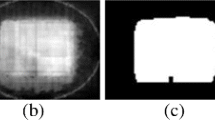Abstract
Saliency or salient region extraction from images is still a challenging field as it needs some understanding of the image and its nature. A technique that is suitable for some applications is not necessarily useful in other applications, thus, saliency identification is dependent upon the application. Based on a survey of existing methods of saliency detection, a new technique to extract the salient regions from an image is proposed that utilizes local features of the region surrounding each pixel. The level of saliency is decided based on the irregularity of the region with compared to other regions. To make the process fully automatic, a new Fuzzy-based thresholding technique has also been developed. In addition to the above, a survey of existing saliency evaluation techniques has been carried out and we have proposed new evaluation methods. The proposed saliency extraction technique has been compared with other algorithms reported in the literature, and the results are discussed in detail.

















Similar content being viewed by others
References
Achanta, R., Estrada, F., Wils, P. & SÄusstrunk, S., 2008. Salient Region Detection and Segmentation. s.l., s.n., pp. 66–75.
Achanta, R., Hemami, S., Estrada, F. & Susstrunk, S., 2009. Frequency-tuned Salient Region Detection. s.l., IEEE Conference on Computer Vision and Pattern Recognition. CVPR 2009.
Achanta, R. & Susstrunk, S., 2010 . Saliency detection using maximum symmetric surround. Hong Kong, s.n.
Al-Azawi M, Yang Y, Istance H (2014) A new gaze points agglomerative clustering algorithm and its application in regions of interest extraction. IEEE International Advance Computing Conference (IACC), Gurgaon
Anon., 2013. Precision and recall. [Online] Available at: https://en.wikipedia.org/wiki/Precision_and_recall [Accessed 15 8 2013].
Arivazhagan S, Shebiah RN (2009) Object recognition using wavelet based salient points. Open Signal Process J 2:14–20
Banerjee, M. & Kundu, M. K., 2003. Edge based features for content based image retrieval. Pattern Recognition, Issue 36, pp. 2649–2661
Borji, A., Sihite, D. N. & Itti, L., 2012. Salient Object Detection: A Benchmark. Florence, Italy, 12th European Conference on Computer Vision Proceedings, Part II, pp. 414–429.
Bruce, N., Loach, D. & Tsotsos, J., 2007. Visual Correlates of Fixation Selection: A Look at the Spatial Frequency Domain. San Antonio, TX, s.n.
Burns, R. B. & Burns, R. A., 2008. Chapter 23: Cluster Analysis. In: Business Research Methods and Statistics Using SPSS. s.l.: Sage Publications Ltd., pp. 552–567.
Choi YS, Mosley AD, Stark LW (1995) String editing analysis of human visual search. Optom Vis Sci 72:439–445
Cook, D. & Swayne, D. F., 2007. chapter 5: Cluster Analysis. In: Interactive and Dynamic Graphics for Data Analysis. s.l.:Springer, pp. 103–128.
Davis, J. & Sharma, V., 2004. Robust Background Subtraction for Person Detection in Thermal Imagery. s.l., Proc. of the IEEE Conference on Computer Vision and Pattern Recognition Workshops (CVPRW’04), pp. 128–132.
Einhauser W, Spain M, Perona P (2008) Objects predict fixations better than early saliency. J Vis 8(14–18):1–26
Erdem E, Erdem A (2013) Visual saliency estimation by nonlinearly integrating features using region covariances. J Vis 13(4–11):1–20
Estivill-Castro V (2002) Why so many clustering algorithms: a position paper. ACM SIGKDD Explor Newsl 4(1):65–75
Fang, Y., Chen, Z., Lin, W. & Lin, C.W., 2011. Saliency-based Image Retargeting in the Compressed Domain. s.l., ACM International Conference on Multimedia 2011 (ACM MM11).
Fang Y, Chen Z, Lin W, Lin CW (2012) Saliency detection in the compressed domain for adaptive image retargeting. Trans Image Process 9(21):3888–3901
Fang Y et al (2012) Bottom–Up saliency detection model based on human visual sensitivity and amplitude spectrum. IEEE Trans Multimedia 14(1):187–198
Gide, M. & Karam, L., 2012. Improved foveation- and saliency-based visual attention prediction under a quality assessment task. s.l., s.n., pp. 200–205 .
Gopalakrishnan, V., Hu, Y. & Rajan, D., 2009. Random walks on graphs to model saliency in images. Miami, FL, s.n.
Harel J, Koch C, Perona P (2007) Graph-based visual saliency. Adv Neural Inf Process Syst 19:545–552
Hou, X. & Zhang, L., 2007. Saliency detection: A spectral residua approach.. s.l., s.n.
Hou, X. & Zhang, . L., 2007. Saliency Detection: A Spectral Residual Approach. Minneapolis, MN, s.n.
Hu, Y. et al., 2005. Salient Region Detection Using Weighted Feature Maps Based on the Human Visual Attention Model. s.l., Proc. Fifth Pacific Rim Conf. Multimedia, pp. 993–1,000.
Itti L, Koch C, Niebur E (1998) A model of saliency-based visual attention for rapid scene analysis. IEEE Trans Pattern Anal Mach Intell 20(11):1254–1259
Ivanoff RM, Klein J (2008) Inhibition of return. Scholarpedia 3(10):3650
Jain AK, Murty MN, Flynn PJ (1999) Data clustering: a review. ACM Comput Surv (CSUR) Surv 31(3):264–323
Judd, T., Durand, . F. & Torralba, A., 2012. A Benchmark of Computational Models of Saliency to Predict Human Fixations, s.l.: CSAIL Technical Reports.
Kadir T, Brady M (2001) Scale, saliency and image description. Int J Comput Vis 45(2):83–105
Kapsalas, P., Rapantzikos, K., Sofou, A. & Avrithis, Y., 2008. Regions of interest for accurate object detection. London, s.n., pp. 147–154 .
Kim C, Milanfar P (2013) Visual saliency in noisy images. J Vis 13(4–5):1–14
Kim, S., Park, S. & Kim, M., 2003. Central object extraction for object-based image retrieval, CIVR’03. Heidelberg, s.n., pp. 39–49.
Koch C, Ullman S (1985) Shifts in selective visual attention: towards the underlying neural circuitry. Hum Neurobiol 4:219–227
Le Meur O, Callet PL, Barba D, Thoreau D (2006) A coherent computational approach to model bottom–Up visual attention. IEEE Trans Pattern Anal Mach Intell 28(5):802–817
Li J et al (2007) Visual saliency based on scale-space analysis in the frequency domain. J Latex Class Files 6(1):1–16
Lin, Y., Fang, B. & Tang, Y., 2010. A Computational Model for Saliency Maps by Using Local Entropy. tlanta, Georgia, USA, Proceedings of the Twenty-Fourth AAAI Conference on Artificial Intelligence (AAAI-10).
Lin DW, Yang SH (2007) Wavelet-based salient region extraction. In: advances in multimedia information processing—PCM 2007, vol 4810. Springer, Honk Kong, pp 389–392
Lin Y et al (2013) A visual-attention model using earth Mover’s distance-based saliency measurement and nonlinear feature combination. IEEE Trans Pattern Anal Mach Intell 35(2):314–328
Liu Z, Xue Y, Yan H, Zhang Z (2011) Efficient saliency detection based on gaussian models. IET Image Process 5(2):122–131
Liu, T. et al., 2007. Learning to Detect a Salient Object. s.l., Proc. IEEE CS Conf. Computer and Vision Pattern Recognition, pp. 1–8.
Loupias, E., Sebe, N., Bres, S. & Jolion, J.M., 2000. Wavelet-based salient points for image retrieval. Vancouver, BC, Canada, s.n., pp. 518–521.
Luo, S. et al., 2013 . Efficient saliency detection using regional color and spatial information. Paris, s.n.
Ma, Y.F. & Zhang, H.J., 2003 . ontrast-based image attention analysis by using fuzzy growing. s.l., s.n.
Mancas, M., 2008. Image Perception: Relative Influence of Bottom–Up and Top-Down Attention. s.l., Proc. Int’l Workshop Attention and Performance in Computer Vision in conjunction with the Int’l Conf Computer Vision Systems, pp. 94–106.
Margolin, R., Tal, A. & Zelnik-Manor, L., 2013. What Makes a Patch Distinct?. s.l., CVPR ’13 Proceedings of the 2013 I.E. Conference on Computer Vision and Pattern Recognition.
Milligan G, Cooper M (1987) Methodology review: clustering methods. Appl Psychol Meas 11(4):329–354
Parkhurst, D., Law, K. & Nieb, E., 2002. Modeling the role of salience in the allocation of overt visual attention. Vision Research, Issue 42, pp. 107–123
Pele, O. & Werman, M., 2008. A Linear Time Histogram Metric for Improved SIFT Matching. Marseille, France, Proceeding ECCV ′08 Proceedings of the 10th European Conference on Computer Vision: Part III, pp. 495–508.
Perazzi F, Krähenbül P, Pritch Y, Hornung A (2012) Saliency filters: contrast based filtering for salient region detection. IEEE CVPR, Rhode Island
Peters R, Iyer A, Itti L, Koch C (2005) Components of bottom–up gaze allocation in natural images. Vision Res 45:2397–2416
Rahmani, R. et al., 2008. Localized Content Based Image Retrieval. IEEE TRANSACTIONS ON PATTERN ANALYSIS AND MACHINE INTELLIGENCE, SPECIAL ISSUE, pp. 1–10
Rai P, Singh S (2010) A survey of clustering techniques. Int J Comput Appl 7(12):1–5
Rosin PL (2009) A simple method for detecting salient regions. Pattern Recognit 42:2363–2371
Rubner Y, Tomasi C, Guibas L (2000) The earth mover’s distance as a metric for image retrieval. Int J Comput Vis 40(2):99–121
Schmid C, Mohr R (1997) Local greyvalue invariants for image retrieval. IEEE Trans Pattern Anal Mach Intell 19(5):530–535
Schmid C, Mohr R, Bauckhage C (2000) Evaluation of interest point detectors. Int J Comput Vis 37(2):151–172
Sebe N et al (2002) Evaluation of salient point techniques. Image Vision Comput 21:367–377
Song, H., Li, B. & Zhang, L., 2006. Color Salient Points Detection Using Wavelet. Dalian, China, Proceedings of the 6th World Congress on Intelligent Control and Automation.
Stöttinger, J., Hanbury, A.,. & Gevers, T., 2009. Lonely but attractive: Sparse color salient points for object retrieval and categorization. Miami, FL, IEEE Computer Society Conference on Computer Vision and Pattern Recognition Workshops, 2009. CVPR Workshops 2009., pp. 1–8
Tan, P.N., Steinbach, M. & Vipin, K., 2006. Cluster Analysis: Basic Concepts and Algorithms. In: Introduction to Data Mining. s.l.:Addison-Wesley Companion, pp. 488–568.
Tatler BW, Hayhoe MM, Land MF, Ballard DH (2011) Eye guidance in natural vision: reinterpreting salience. J Vis 11(11–5):1–23
Tian Q et al (2001) Image retrieval using wavelet-based salient points. J Electron Imaging 10(4):835–849
Toet A (2011) Computational versus psychophysical bottom–Up image saliency: a comparative evaluation study. IEEE Trans Pattern Anal Mach Intell 33(11):2131–2146
Tryfos, P., 1998. Chapter 15: Cluster analysis. . In: Methods for Business Analysis and Forecasting: Text & Cases, . s.l.:Wiley.
Xu R, Wunsch D (2005) Survey of clustering algorithms. IEEE Trans Neural Netw 16(3):645–678
Zhang L (2008) SUN: a bayesian framework for saliency using natural statistics. J Vis 8(7–32):1–20
Zhang, H. & Goldman, S. A., 2006. Image Segmentation Using Salient Points-Based Object Templates.. Atlanta, GA, 2006 I.E. International Conference on Image Processing,, pp. 765–768
Zhao Q, Koch C (2011) Learning a saliency map using fixated locations in natural scenes. J Vis 11(3–9):1–15
Zhou, B., Hou, X. & Zhang, L., 2010. A phase discrepancy analysis of object motion. Queenstown, New Zealand, Proceedings of the 10th Asian conference on Computer vision ACCV’10, pp. 225–238.
Author information
Authors and Affiliations
Corresponding author
Rights and permissions
About this article
Cite this article
Al-Azawi, M., Yang, Y. & Istance, H. Irregularity-based image regions saliency identification and evaluation. Multimed Tools Appl 75, 25–48 (2016). https://doi.org/10.1007/s11042-014-2248-z
Received:
Revised:
Accepted:
Published:
Issue Date:
DOI: https://doi.org/10.1007/s11042-014-2248-z




